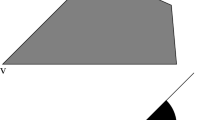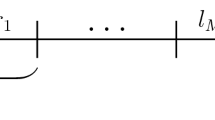Abstract
We consider random interlacements on \({\mathbb {Z}}^d\), \(d\ge 3\), when their vacant set is in a strongly percolative regime. We derive an asymptotic upper bound on the probability that the random interlacements disconnect a box of large side-length from the boundary of a larger homothetic box. As a corollary, we obtain an asymptotic upper bound on a similar quantity, where the random interlacements are replaced by the simple random walk. It is plausible, but open at the moment, that these asymptotic upper bounds match the asymptotic lower bounds obtained by Xinyi Li and the author in (Electron. J. Probab. 19(17):1–26, 2014), for random interlacements, and by Xinyi Li in (A lower bound on disconnection by simple random walk. arXiv:1412.3959, 2014), for the simple random walk. In any case, our bounds capture the principal exponential rate of decay of these probabilities, in any dimension \(d \ge 3\).
Similar content being viewed by others
References
van den Berg, M., Bolthausen, E., den Hollander, F.: Moderate deviations for the volume of the Wiener sausage. Ann. Math. 153(2), 355–406 (2001)
Cerf, R.: Large deviations for three dimensional supercritical percolation. Astérisque 267, Société Mathématique de France (2000)
Černý, J., Teixeira, A.: From random walk trajectories to random interlacements. Ensaios Matemáticos, vol. 23 (2012)
Comets, F., Gallesco, Ch., Popov, S., Vachkovskaia, M.: On large deviations for the cover time of two-dimensional torus. Electron. J. Probab. 96, 1–18 (2013)
Drewitz, A., Ráth, B., Sapozhnikov, A.: Local percolative properties of the vacant set of random interlacements with small intensity. Ann. Inst. Henri Poincaré Probab. Stat. 50(4), 1165–1197 (2014)
Drewitz, A., Ráth, B., Sapozhnikov, A.: An introduction to random interlacements. SpringerBriefs in Mathematics, Berlin (2014)
Durrett, R.: Probability: theory and examples. Wadsworth and Brooks/Cole, Pacific Grove (1991)
Grimmett, G.: Percolation, 2nd edn. Springer, Berlin (1999)
Lawler, G.F.: Intersections of random walks. Birkhäuser, Basel (1991)
Li, X.: A lower bound on disconnection by simple random walk. Ann. Probab. (2014, to appear). arXiv:1412.3959
Li, X., Sznitman, A.S.: Large deviations for occupation time profiles of random interlacements. Probab. Theory Relat. Fields 161, 309–350 (2015)
Li, X., Sznitman, A.S.: A lower bound for disconnection by random interlacements. Electron. J. Probab. 19(17), 1–26 (2014)
Marcus, M.B., Rosen, J.: Markov processes, Gaussian processes, and local times. Cambridge University Press, Cambridge (2006)
Popov, S., Teixeira, A.: Soft local times and decoupling of random interlacements. J. Eur. Math. Soc. (2012, to appear). arXiv:1212.1605
Port, S., Stone, C.: Brownian motion and classical potential theory. Academic Press, New York (1978)
Sidoravicius, V., Sznitman, A.S.: Percolation for the vacant set of random interlacements. Commun. Pure Appl. Math. 62(6), 831–858 (2009)
Spitzer, F.: Principles of random walk, 2nd edn. Springer, Berlin (2001)
Sznitman, A.S.: Vacant set of random interlacements and percolation. Ann. Math. 171, 2039–2087 (2010)
Sznitman, A.S.: Decoupling inequalities and interlacement percolation on \({G} \times {Z}\). Invent. Math. 187(3), 645–706 (2012)
Sznitman, A.S.: An isomorphism theorem for random interlacements. Electron. Commun. Probab. 17(9), 1–9 (2012)
Sznitman, A.S.: Random interlacements and the Gaussian free field. Ann. Probab. 40(6), 2400–2438 (2012)
Sznitman, A.S.:. Disconnection and level-set percolation for the Gaussian free field. J. Math. Soc. Japan 7(4),1801–1843 (2015, special issue on the centennial of the birth of Kiyosi Itô)
Teixeira, A.: On the size of a finite vacant cluster of random interlacements with small intensity. Probab. Theory Relat. Fields 150(3–4), 529–574 (2011)
Windisch, D.: On the disconnection of a discrete cylinder by a biased random walk. Ann. Appl. Probab. 18(4), 1441–1490 (2008)
Author information
Authors and Affiliations
Corresponding author
Appendix
Appendix
In this appendix we provide the proof of Lemma 2.3. The arguments are similar to p. 50 of [9]. The proof is included for the reader’s convenience.
Proof of Lemma 2.3
The uniqueness in the statement is immediate. Only the existence is at stake. We first observe that if \(z \in \partial U\) does not belong to the boundary the connected component of U containing B(0, L), all three members of (2.21) vanish (and (2.21) holds with \(\psi ^{A,U}_{y,z} = 0\)). We can thus assume from now on that U is connected.
The first equality \(P_z[H_A < \widetilde{H}_{\partial U}, X_{H_A} = y] = P_y[T_U < \widetilde{H}_A, X_{T_U} = z]\), with \(y \in A\) and \(z \in \partial U\), is obtained by time-reversal (one sums over the possible values in the discrete skeleton of the walk, of the entrance time in A, for the probability on the left, and of the exit time of U, for the probability on the right). It then suffices to show that when \(K \ge c\), for \(y \in A\), \(z \in \partial U\), one has
One introduces the function on \({\mathbb {Z}}^d\)
It is positive and harmonic in \(U \supseteq B(0,KL)\). When \(K \ge c\), it follows from the gradient control in Theorem 1.7.1, on p. 42 of [9], and the Harnack inequality in Theorem 1.7.2, on p. 42 of [9], that for \(x \in D \cup \partial D\), where \(D = B(0,2L)\),

(using chaining in the last step).
Noting that \(T_D\) happens before \(T_U\), we find that by the strong Markov property
Now, for \(x \in \partial D\) we have
As a result of (A2) we see that

In addition, it follows by (A4) that for \(x \in \partial D\)
Further, we note that for \(x \in \partial D\)
and setting for \(x \in \partial D\)
As a result, we obtain that for \(x \in \partial D\)
where we have set

Coming back to (A3) we obtain (with \(X_{T_D}\) playing the role of x in (A9)) that

where we note that when \(e_{A,U}(y) = P_y [T_U < \widetilde{H}_A] > 0\), then \(e_A(y) = P_y[\widetilde{H}_A = \infty ] > 0\) (because \(e_{A,U}(y) \le e_{A,B(0,KL)}(y)\) and (2.16)), and the ratio above is understood as 1 if \(e_A(y)\) vanishes. We thus see that the ratio in the last line of (A11) lies between 1 and \(1 + \rho _{A,B(0,KL)} \le (1 - \frac{c}{K^{d-2}})^{-1}_+\), by (2.18) of Lemma 2.2 and (2.8).
Thus, looking at the last line of (A11), we see that when \(K \ge c\),
Rights and permissions
About this article
Cite this article
Sznitman, AS. Disconnection, random walks, and random interlacements. Probab. Theory Relat. Fields 167, 1–44 (2017). https://doi.org/10.1007/s00440-015-0676-y
Received:
Revised:
Published:
Issue Date:
DOI: https://doi.org/10.1007/s00440-015-0676-y




